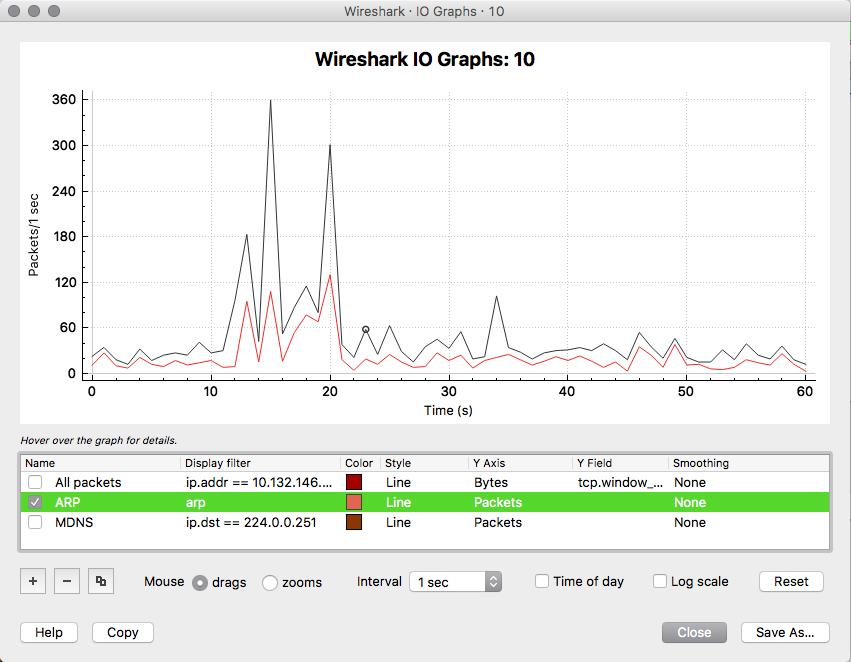
- #WIRESHARK FILTER ARP HOW TO#
- #WIRESHARK FILTER ARP FREE#
- #WIRESHARK FILTER ARP MAC#
- #WIRESHARK FILTER ARP WINDOWS#
Now suppose you want to capture all traffic using specific protocols generated by a host, such as pop3, ftp, http, or messenger. Instead of the ip.addr filter you can use the capture filter “Host” in this way: host 192.168.0.1īy entering this setting as a capturing filter, Wireshark captures all traffic to and from 192.168.0.1, regardless of the type. With the option “ip” selected, all Internet Protocol traffic is shown, which is fine in the 99% of cases.
#WIRESHARK FILTER ARP MAC#
Then run the arp command:Ĭlick apply, and you will see only the traffic that is coming from, or going to, that IP or MAC address. To get the mac-address of the target on the other end of the connection, first issue a ping command to the hostname or URL of the target computer to learn its IP address.

You could filter for mac-address to be sure to pinpoint the right client. Now suppose you want to see all the traffic coming in and out of one specific computers. You can also isolate only requests toward a specific site – Facebook, for example – to see which IP addresses are requesting it, by placing the filter contains facebook in the Filter field.
#WIRESHARK FILTER ARP WINDOWS#
To do that, choose an http request in the main windows where you see all the packets, right-click on it, and choose the option “Follow TCP Stream.” Wireshark will open a new window containing the reconstruction of that entire HTTP session in chronological order. Perhaps you are interested in following a particular kind of information, or a particular user. Each web page that any users on your network visits will generate this kind of traffic for you to catch – which may be a lot of information. You can click on Edit -> Preferences -> Protocols -> HTTP and verify that “Uncompress entity bodies” is checked.ĭuring the capture, set a filter to show only HTTP traffic by entering http. Today, most HTTP traffic is compressed to speed up the exchange of information, so by default Wireshark decompresses the body part of HTTP packets. As before, start Wireshark and start capturing the traffic from the interface that goes out. Here’s another classic example – an HTTP session.
#WIRESHARK FILTER ARP HOW TO#
In this article we’ll see how apply BPF filters to wireshark to show the details of an HTTP session, an e-mail session and how to monitor who is visiting a certain site from our local network.įinally I will make a summary of the most useful filters to use with Wireshark. It’s implemented for security reason.This is an article of mine, first published on Wazi

That means somebody sends ARP reply on behave of original device. Proxy ARP: From the name we can understand that when one device sends an ARP request and gets an ARP reply but not form the actual device. This is to avoid IP conflict in same network.
#WIRESHARK FILTER ARP FREE#
Gratuitous ARP: When a system gets an IP address after that system is free to send a gratuitous ARP informing the network that I have this IP. That means you have MAC address of PC2 but you do not have IP address of PC2. RARP: Its opposite of normal ARP that we have discussed. Now ping should be successful as ARP has been resolved. Here are the important fields of ARP reply.įrom this ARP reply we go that PC1 got PC2 MAC and updated ARP table. So we understand that the main intention of ARP request to get the MAC address of PC2.ĪRP reply is sent by PC2 after receiving ARP request. Here are important fields for ARP Request. We did ping to 192.168.1.1 so before sending ICMP request, PC1 should send broadcast ARP request and PC2 should send unicast ARP reply.

There are other two types RARP Request and RARP Reply but used in specific cases. So PC1 got MAC address of PC2 and able to send ICMP packet.įor more information on ICMP please see here

Now we will check what happens in background when we delete arp entry and ping to a new IP address.Īctually when we ping 192.168.1.1, before sending ICMP request packet there was ARP Request and ARP reply packet exchanges.


 0 kommentar(er)
0 kommentar(er)
